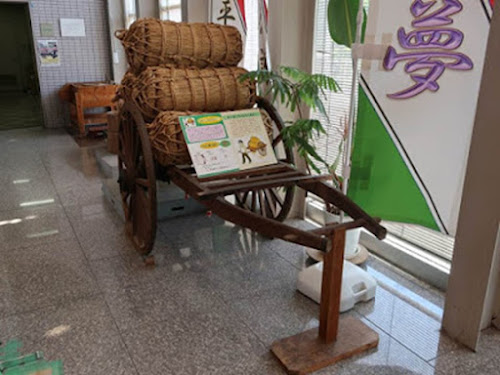They finished harvesting and threshing, so it
was an agricultural off-season. They started repairing the embankment of horse
stock farms and also started forest work. The 15th of this month is “Shichi-Go-San” day, which literally means
“Seven-Five-Three” day; people celebrate the growth of 7-year-old girls, 5-year-old boys and 3-year-old girls. Many topics of grandchildren were written.
By the way, his father went out very often;
in the 45-day period from the 1st of November to the 15th
of December, he went out for 33 days. He seemed to have good relatives or
acquaintances where he could relax and refresh. |
Outfits
of “Seven-Five-Three” celebration
ちゃぁみいさんによるACの写真
|
稲の刈り入れが終わり、脱穀が終わり、農閑期に入る。土手普請や冬仕事の山刈りが始まる。また、11月15日の七五三を迎え、孫の話が頻出する。ところで、父の外出は続く。11月1日から翌12月15日までの45日間で、33日間外出。私も外出好きだが、すごい頻繁だ。10km離れた柏も多く、落ち着く親戚や知人がいるようだ。
On the 3rd and the 4th,
they brought rice to Naraya (maybe wholesaler) in Nagareyama.
B.
Kikuya, who was an oshi agent of Fuji and probably his relative,
visited. The master donated $500 (in current value) to him because he was in
difficulties.  |
Shipping on the cart、大八車で出荷
|
Tax
payment、納税
On the 6th, the master
received the letter from the local government office which asked him to
dispatch workers to repair banks of horse stock farms. The work started from
the 11th. He dispatched 5 workers on the 12th and the 13th,
3 workers on the 14th. The seal, which certificated they finished
the work, was issued on the 16th.
On the 7th, Gisaburou
helped the neighbor for milling. Meanwhile, the master visited K. Nakamura to
join the Mujin party which was the last one of this year.
On the 8th, he shipped
the first rice tax (555kg of rice) and he finished tax payment next day. The master
visited Edo on the 10th; I guess he got a receipt of the tax from
the lord. He carried out his duty. On the other hand, they started the forest
work on this day. They gathered firewood from the 11th to the 16th
of this month.
 |
Weighing of the rice tax、年貢米の計量 @ Kanagawa Prefectural Museum
of Cultural History (part1)、神奈川県立歴史博物館(1)
|
6日、土手普請の人足要請の手紙が金が作の代官所から届く。土手普請は、11日から始まり、12日は人足5人、13日も5人、14日は3人を送っている。上野牧の捕込の修復である。16日には、土手完成の印行調印をしている。
7日、義三郎は隣家の唐臼挽きを手伝いに行く。主は、中村勘右衛門へ無盡に行く。この年、最後の無盡の記述となる。
8日、初お年貢米37俵斗立(はかりだて。貢米一俵を三斗五升とし、延米二升を加えて納入したこと/Weblio辞書、37俵は555kg)とあり、翌9日には、お年貢米皆済、とある。主は10日に出府し、翌11日夜に帰宅しているので、年貢を納めた確認か。今年も義務を果たした。また、蒔刈、とあり山仕事がはじまる。11日から16日までは薪などを集める山仕事をしている。
Celebration
of the growth of children、子ども達の成長を祝う
On the 9th, he got a
letter from Mr. Inamura which mentioned the birth of his granddaughter. He visited Inamura
on the 30th; he offered the money for baby clothes and stayed at
Inamura’s house. They had so close relationship.
 |
Baby
clothes、赤ちゃんに贈った「一つ身綿入れ」
|
On the 10th, he offered mochi rice
cake to the grandchild of Shibaya for the “Obitoki” celebration. “Obi” means a
belt; they celebrated the day when children started using Obi; it was the 15th
of November, when boys' age was five and girls' age was seven. It is called
“Shichi-Go-San” now. People lived in a very close community back then, I think it was cozy
usually but it was nuisance occasionally.
On the 14th, he visited Shibaya to
celebrate Obitoki.
On the 15th, Okono and Aisuke also visited
Shibaya.
 |
Decorated obi belt of kimono which is used on
the celebration day
FineGraphicsさんによるACの写真
|
9日、稲村家から女子誕生の書状が来る。主は、30日に子神参詣の後、産衣料を持参して稲村丈右衛門を訪ね、泊まっている。付き合いが密だ。
10日、芝弥の孫が、帯解ということで、餅を差し入れている。近所との密接な付き合いはよいことだが、面倒かも知れない。福島県南会津の桧枝岐の住民が、「村民の関係が深く、みんなで子育てしているような感じだが、時に、関係が深すぎてちょっと嫌な時がある」とTVで語っていたのが思い出される。
*帯解き:着物についた紐で結んで着物を着ていた子どもが、帯で結ぶようになる儀式。江戸時代からは男子は5歳(袴着)に、女子は7歳(帯解き)として、子どもの成長を祝う七五三の行事になっている。女子の3歳は髪置き。11月15日に行われる。
14日、芝弥の孫の帯解きで、主人が芝弥を訪ねている。
15日、芝弥の孫の帯解きで、今度はおこのと愛輔が芝弥を訪ねている。
Father’s
trip、父の小旅行
On the 18th, his father went to
Kashiwa and visited Okinu; he stayed there. On the 19th, he stayed at
acquaintance’s house in Natogaya. On the 20th, he stayed at Nadugari.
He visited Toyozou next day, then he returned home, so it was four-day trip. He
went out often, and his companies kindly treated him, otherwise he couldn’t
visit them because he moved on foot.
18日、父は、柏で用事があり、その後、おきぬを見舞って泊まる。翌19日は名戸が谷、20日は名都借(なづがり)で泊まって、21日に豊蔵に寄ってから帰っている。良く出かける人だし、簡単に泊まれるようになっていたものだ。徒歩旅行の時代は、泊まらせてもらわないと困る。
From the 21st to the 24th,
they ground rice. Next month, they milled rice to make mochi rice cake, but
I’m not sure what they made from powder rice. Meanwhile his mother went to
Kashiwa, with Kanzaemon’s wife. It was regarding to a wedding. It was
off-season for farmers, so they could have much time to intermediate, I think.
On the 27th, the master
went to Edo to talk about the temporary tax of Kogane village and returned two
days later. He probably begged something to the lord. On this day, they went to
Nagareyama to sell twenty sheets of straw mats. Making mats were job during off-season.
They also brought miso paste to Nakadera temple.
On the 28th, he went to the village
shrine to appreciate his granddaughter Mitsu’s growth. It was 110 days after
her birth.
On the 30th, he visited J. Inamura
to celebrate the birth of the grandchild.
 |
Making straw mat、むしろ作り
|
21日、この日から4日間、唐臼挽、これは米粉まで作れるつき臼だ。4日続けて、何用の米を作っていたのかなあ。12月21日から24日まで「米搗き」と記載があり、25日が米臼、26日は餅つきなので、米搗きは、もち米の精米あったと思う。米臼、という言葉も多出するので、こちらは食用の精米だと思う。
母は勘左衛門の妻と柏に行くが、「嫁口の儀」とあり、農閑期の結婚の世話だろうか。
27日、主は、小金助郷の件で出府とあり、2日後に帰る。陳情だろう。筵20枚樽屋へ、とあり、冬仕事で作った筵を売りに行っているようだ。中寺へは、味噌を壱重持参している。
28日、みつ(8月に誕生したおこのの子と思われる)の百十日に付き、鎮守に参詣している。
30日は、山刈りと既述の孫の出産祝いを持って稲村丈右衛門を訪問だ。一泊する。
Previous
post: Yoshino’s
daily life 23, October in 1851(嘉永4年10月)
Next
post: Yoshino’s daily life 25, December in 1851 嘉永4年12月Yoshino’s daily life 02, Life and fun of Yoshino family 吉野家の暮らしと楽しみ
Comments
Post a Comment